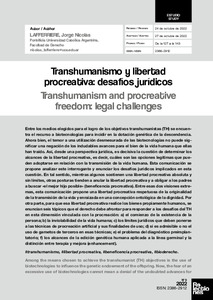Por favor, use este identificador para citar o enlazar este ítem:
https://repositorio.uca.edu.ar/handle/123456789/15642| Campo DC | Valor | Lengua/Idioma |
|---|---|---|
| dc.contributor.author | Lafferrière, Jorge Nicolás | es |
| dc.date.accessioned | 2022-12-14T15:31:02Z | - |
| dc.date.available | 2022-12-14T15:31:02Z | - |
| dc.date.issued | 2022 | - |
| dc.identifier.citation | Lafferriere, J.N. Transhumanismo y libertad procreativa: desafíos jurídicos [en línea]. Relectiones. 2022, 9. doi:10.32466/eufv-rel.2022.9.752.127-143. Disponible en: https://repositorio.uca.edu.ar/handle/123456789/15642 | es |
| dc.identifier.issn | 2386-2912 | - |
| dc.identifier.issn | 2386-8732 (online) | - |
| dc.identifier.uri | https://repositorio.uca.edu.ar/handle/123456789/15642 | - |
| dc.description.abstract | Resumen: Entre los medios elegidos para el logro de los objetivos transhumanistas (TH) se encuentra el recurso a biotecnologías para incidir en la dotación genética de la descendencia. Ahora bien, el temor a una utilización desmesurada de las biotecnologías no puede significar una negación de los indudables avances para el bien de la vida humana que ellas han traído. Así, desde una perspectiva jurídica, es decisiva la cuestión de determinar los alcances de la libertad procreativa, es decir, cuáles son las opciones legítimas que pueden adoptarse en relación con la transmisión de la vida humana. Esta comunicación se propone analizar este interrogante y enunciar los desafíos jurídicos implicados en esta cuestión. En tal sentido, mientras algunos sostienen una libertad procreativa absoluta y sin límites, otras posturas tienden a anular la libertad procreativa y a obligar a los padres a buscar «el mejor hijo posible» (beneficencia procreativa). Entre esas dos visiones extremas, esta comunicación propone una libertad procreativa respetuosa de la originalidad de la transmisión de la vida y enraizada en una concepción ontológica de la dignidad. Por otra parte, para que esa libertad procreativa realice los bienes propiamente humanos, se enuncian seis tópicos que el derecho debe afrontar para responder a los desafíos del TH en esta dimensión vinculada con la procreación: a) el comienzo de la existencia de la persona; b) la inviolabilidad de la vida humana; c) los límites jurídicos que deben ponerse a las técnicas de procreación artificial y sus finalidades de uso; d) si es admisible o no el uso de gametos de terceros en esas técnicas; e) el problema del diagnóstico preimplantatorio; f) los alcances de la edición genética humana aplicada a la línea germinal y la distinción entre terapia y mejora (enhancement). | es |
| dc.description.abstract | Abstract: Among the means chosen to achieve the transhumanist (TH) objectives is the use of biotechnologies to influence the genetic endowment of the offspring. Now, the fear of an excessive use of biotechnologies cannot mean a denial of the undoubted advances for the good of human life that they have brought. Thus, from a legal perspective, the question of determining the scope of procreative freedom is decisive, that is, what are the legitimate options that can be adopted in relation to the transmission of human life. This communication aims to analyze this question and state the legal challenges involved in this issue. In this sense, while some support absolute and unlimited procreative freedom, other positions tend to annul procreative freedom and force parents to look for«the best possible child” (procreative charity). Between these two extreme visions, this communication proposes a procreative freedom respectful of the originality of the transmission of life and rooted in an ontological conception of dignity. On the other hand, for this procreative freedom to realize properly human goods, six topics are stated that the law must address in order to respond to the challenges of HT in this dimension linked to procreation: a) the beginning of the existence of the person; b) the inviolability of human life; c) the legal limits that must be placed on artificial procreation techniques and their purposes of use; d) whether or not the use of third party gametes in these techniques is admissible; e) the problem of preimplantation diagnosis; f) the scope of human gene editing applied to the germ line and the distinction between therapy and enhancement. | es |
| dc.format | application/pdf | es |
| dc.language.iso | spa | es |
| dc.publisher | Universidad Francisco de Vitoria | es |
| dc.relation | Bioderecho: desafíos jurídicos para la persona humana planteados por la genética y las biotecnologías | es |
| dc.rights | Acceso abierto | * |
| dc.rights.uri | http://creativecommons.org/licenses/by-nc-sa/4.0/ | * |
| dc.source | Relectiones. 2022. 9 | es |
| dc.subject | TRANSHUMANISMO | es |
| dc.subject | LIBERTAD | es |
| dc.subject | PROCREACION | es |
| dc.subject | BIODERECHO | es |
| dc.title | Transhumanismo y libertad procreativa: desafíos jurídicos | es |
| dc.title | Transhumanism and procreative freedom: legal challenges | es |
| dc.type | Artículo | es |
| dc.identifier.doi | 10.32466/eufv-rel.2022.9.752.127-143 | - |
| uca.disciplina | DERECHO | es |
| uca.issnrd | 1 | es |
| uca.affiliation | Fil: Lafferrière, Jorge Nicolás. Pontificia Universidad Católica Argentina. Facultad de Derecho; Argentina | es |
| uca.version | publishedVersion | es |
| item.fulltext | With Fulltext | - |
| item.grantfulltext | open | - |
| item.languageiso639-1 | es | - |
| crisitem.author.dept | Facultad de Derecho | - |
| crisitem.author.dept | Programa IUS | - |
| crisitem.author.dept | Centro Santa Teresa de Calcuta | - |
| crisitem.author.orcid | 0000-0003-2600-2226 | - |
| crisitem.author.parentorg | Pontificia Universidad Católica Argentina | - |
| crisitem.author.parentorg | Facultad de Derecho | - |
| crisitem.author.parentorg | Facultad de Derecho | - |
| Aparece en las colecciones: | Artículos | |
Ficheros en este ítem:
| Fichero | Descripción | Tamaño | Formato | |
|---|---|---|---|---|
| transhumanismo-libertad.pdf | 256,62 kB | Adobe PDF |  Visualizar/Abrir |
Visualizaciones de página(s)
132
comprobado en 27-abr-2024
Descarga(s)
192
comprobado en 27-abr-2024
Google ScholarTM
Ver en Google Scholar
Altmetric
Altmetric
Este ítem está sujeto a una Licencia Creative Commons

